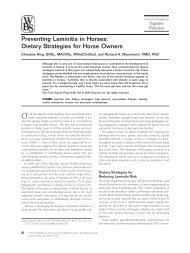Nutritional Secondary Hyperparathyroidism in the Horse
Nutritional Secondary Hyperparathyroidism in the Horse
Nutritional Secondary Hyperparathyroidism in the Horse
You also want an ePaper? Increase the reach of your titles
YUMPU automatically turns print PDFs into web optimized ePapers that Google loves.
82 Experimental <strong>Nutritional</strong> <strong>Secondary</strong> <strong>Hyperparathyroidism</strong> <strong>in</strong> <strong>the</strong> <strong>Horse</strong>.<br />
Table XXII. Weight <strong>in</strong>creases <strong>in</strong> some mammals<br />
Weight (function of birth weight)<br />
Birth 8 weeks of age 16 weeks of age<br />
Sw<strong>in</strong>e* 1 17 40<br />
Dog** 1 8 24<br />
Cat*** 1 7 -<br />
Goat** 1 3 5<br />
<strong>Horse</strong>, Percheron* 1 2.5 3.7<br />
Dairy cattle, Holste<strong>in</strong>* 1 1.7 2.8<br />
Beef cattle* 1 1.6 2.2<br />
*MUMFORD eta]., 1923; **SPECTOR, 1956; ***ALTMAN and DITTMER, 1962.<br />
(1957, 1959) among o<strong>the</strong>rs]. With<strong>in</strong> 3 months <strong>the</strong> bone has almost<br />
disappeared. The osteitis fibrosa is of an extreme hypostotic type.<br />
Spontaneous cases of hyperostotic osteitis fibrosa have been described<br />
<strong>in</strong> <strong>the</strong> cat. In <strong>the</strong> cases described by BAUMANN (1941) and by LIEGEOIS<br />
(1946) <strong>the</strong> swell<strong>in</strong>g of <strong>the</strong> jawbones was so severe as to <strong>in</strong>terfere with<br />
mastication. Dietary data were not presented, but <strong>the</strong> progress of <strong>the</strong><br />
disease was much slower than that <strong>in</strong> <strong>the</strong> experimental cases just<br />
referred to.<br />
ii) The importance of age is well known from spontaneous cases<br />
<strong>in</strong> <strong>the</strong>horse (Chapter 111), cat,goat, sw<strong>in</strong>e, andmonkey [KROOK (1964)l.<br />
This is obviously due to <strong>the</strong> higher normal metabolic rate of bone <strong>in</strong><br />
young <strong>the</strong>n <strong>in</strong> old <strong>in</strong>dividuals. Old age does not prevent <strong>the</strong> disease,<br />
however [KINTNER and HOLT (1932), among o<strong>the</strong>rs]. In renal secondary<br />
hyperparathyroidism <strong>the</strong> age factor is also important <strong>in</strong> <strong>the</strong> pathogenesis<br />
of <strong>the</strong> changes <strong>in</strong> bones. Young dogs with congenital renal<br />
anomalies more often develop hyperostotic osteitis fibrosa than old<br />
dogs with acquired chronic nephropathy [KROOK (1 964)].<br />
iii) Species differences are very obvious. In <strong>the</strong> goat <strong>the</strong> great<br />
majority of reported cases have shown <strong>the</strong> hyperostotic type to be<br />
present [HINTZE (1909); ROSSWOG (1912); LESBOUYRIES and DRIEUX<br />
(1951); TAJIMA and OSHIMA (1951); and general descriptions by<br />
M6cs~ (1959), and COHRS (1961)], although <strong>the</strong> isostotic type may<br />
occur [CHRISTELLER (1923)l. The enlargement of <strong>the</strong> jaw is usually so<br />
prom<strong>in</strong>ent as to <strong>in</strong>terfer with mastication. The swell<strong>in</strong>g of <strong>the</strong><br />
maxillary and nasal bones encroaches upon <strong>the</strong> upper respiratory<br />
passages with dyspnea as a result; hence <strong>the</strong> expressive German term<br />
Scbniiffeelkrankbeit (“sniff<strong>in</strong>g disease”). Spontaneous nutritional second-<br />
Downloaded from<br />
vet.sagepub.com by guest on April 14, 2010



